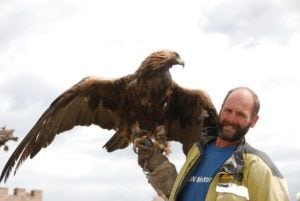Mongolia’s Fascinating Golden Eagle Festival
Our Golden Eagle Festival adventure trip runs through the Trans-Altai Desert and Altai Mountains to deliver us to the Golden Eagle Festival in the far western edge of Mongolia.
Here’s a glimpse into the history of this fascinating tradition of Mongolia’s Kazakh people.
Golden Eagle Festival

Begun in 1999 with 70 eagle hunters, Mongolia’s annual Golden Eagle Festival is recognized as a UNESCO World Heritage Cultural Event.
Kazakh Eagle Hunters celebrate their heritage and compete to catch small animals with trained golden eagles. Hunters parade their decorated horses and hunting outfits in a colourful traditional display of eagles and hunters.
After that, the eagles display their talents in a series of competitive events, like having the eagle catch a fox skin dragged behind a horse and return it to their owner from a distance, on command.
Other events include a camel race, picking up coins from horseback, a girl chase done on horseback (that’s right), and a tug of war over a goat carcass while on horseback. Traditional music is played during the evening.
History of the Hunt
Hunting with eagles began 1,000 years ago, although falconry has been practiced in Central Asia for 6,000 years. Falconry spread around the world, but hunting with eagles remained in Central Asia among the Kazakhs.
When the Russians conquered the region in the 1860s, they suppressed eagle hunting and other traditions, The only place the traditions continued was the region of Bayan-Olgii in Mongolia. An estimated 250 active eagle hunters still exist in Mongolia, compared to 40 in Kazakhstan.
The Art of Training Eagles
Golden Eagles are captured either as babies or adolescents. Females are preferred because they’re more loyal and larger than males, weighing up to seven kilograms (15 lbs.), with a wing span of more than two metres (eight feet).
The hunter starves it for a few days, and then hand feeds it to create an affinity between man and bird. After the eagle becomes familiar with the hunter’s dogs and horses, training begins, with the eagle chasing fox furs at the end of a string pulled by hand or horseback.
Hunting takes place only in winter when foxes, rabbits, and hares’ fur is thick and soft. They’re also much more visible against the white snow.
Eagles live to be more than 30 years old, but Kazakh eagle hunters release them into the wild after 10 years.
History of the Kazakhs
Kazakhs descended from a Mongolian Kingdom near the Aral Sea and are renowned as warrior-nomads. They descended from Mongols and developed a distinct identity and a powerful state until the Russian Empire absorbed them and completely suppressed nomadic herding and their traditional way of life, including eagle hunting.
Many Kazakhs fled into the isolated, ignored, and lawless border region of western China and Mongolia. Here, in the undeveloped steppes and mountain ranges of Mongolia, their traditional nomadic lifestyle was preserved. About half the Kazakhs moved to Kazakhstan after independence in the 1990s, but many returned.
Kazakhs are the second largest ethnic group in Mongolia, and live mostly in Bayan-Olgii, moving with their animals several times a year. The gers, their summer homes, are larger and taller than a Mongolian ger.
Bayan-Olgii sits in the shadows of the highest snow-capped mountains and largest glaciers in Mongolia. Also calling this wilderness home, are bears, wolves, foxes, eagles, wild sheep, ibex, and the elusive snow leopards.
Kazakh Traditions
The Kazakhs have a rich culture, close extended families, and many traditions are centuries old. One of those requires that one must not marry anyone related within nine generations. Kazakhs maintain close ties to families in both Mongolia and Kazakhstan.
Their intricately embroidered wall hangings used on ger walls are famous around the world. Each takes up to 200 hours to create and is patterned after goat horns, a symbol of wealth.
The Kazakhs are known for their outstanding friendliness and welcome to strangers. After meals, they’re likely to pull out a dombra and play traditional folk songs.
Primary Resource: Discover Bavan Olgii

